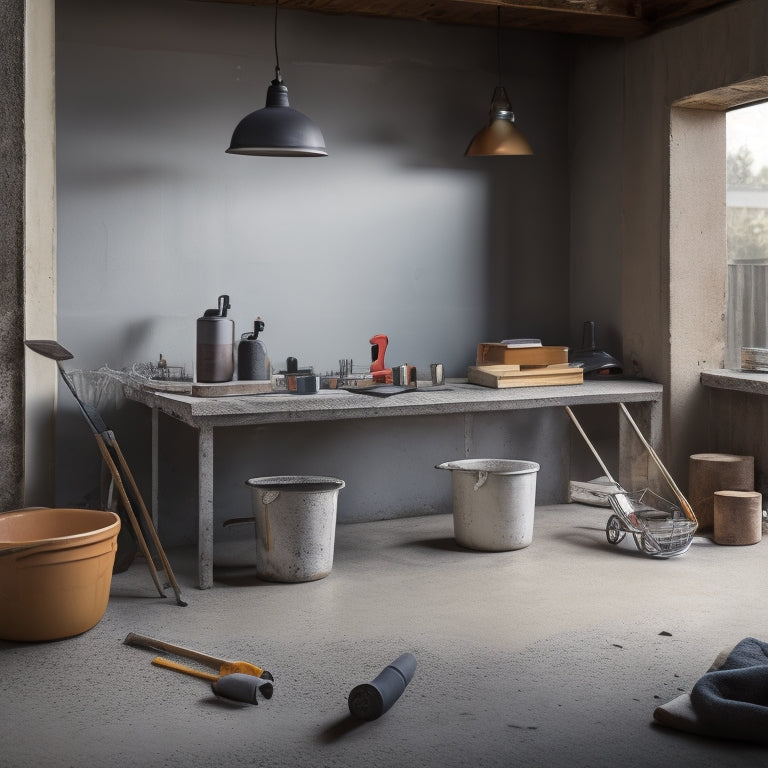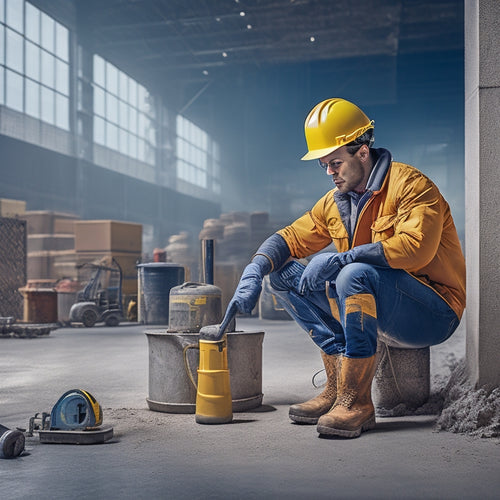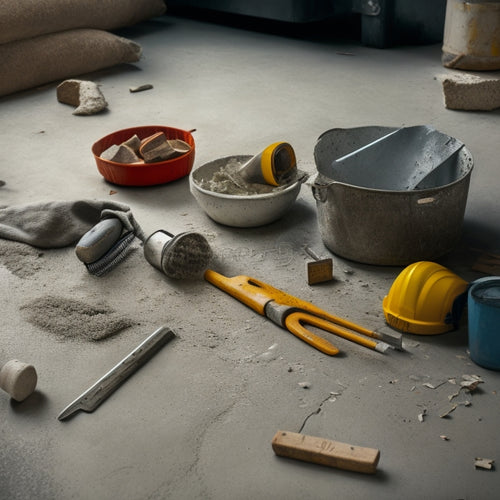
7 Tools You Need for Pouring Concrete Successfully
Share
When pouring concrete, you'll need a range of specialized tools to guarantee success. First, you'll require high-quality concrete mixing equipment, such as batch or continuous mixers, to produce uniform, workable concrete. You'll also need concrete pouring accessories like pumps, pipes, and hoses to efficiently transfer the mix. Next, invest in concrete finishing tools like trowels, floats, and compactors to achieve a smooth, even finish. Additionally, concrete leveling instruments, such as laser levels and spirit levels, will help you detect deviations and guarantee accuracy. In addition, consider concrete vibrating and compacting tools, edging equipment, and curing supplies to enhance durability and quality. As you master these essential tools, you'll be well on your way to achieving a strong, visually appealing concrete finish that meets your project's specific needs.
Key Takeaways
• Select the right concrete mixer type and size based on project scale and specific mixing techniques.
• Use high-quality concrete pouring accessories like pumps, vibrating and compacting tools to ensure efficient flow and consolidation.
• Invest in concrete finishing tools like trowels, floats, and edging equipment to achieve a smooth and professional-looking finish.
• Utilize concrete leveling instruments like laser levels and spirit levels to ensure a smooth, even finish during the pour.
• Apply concrete curing supplies like curing blankets and compounds to promote proper curing and prevent cracks.
Essential Concrete Mixing Equipment
You'll need a sturdy concrete mixer, either a batch mixer or a continuous mixer, to thoroughly combine cement, water, and aggregate into a uniform, workable mix. This equipment is vital for producing high-quality concrete that meets safety standards.
When selecting a mixer, consider the size and type of projects you'll be working on, as well as the specific mixing techniques required. For instance, batch mixers are ideal for small to medium-sized projects, while continuous mixers are better suited for large-scale construction.
Proper equipment maintenance is also fundamental to guarantee the mixer operates efficiently and safely. Regularly inspect and clean the mixer to prevent material buildup and corrosion. Additionally, follow the manufacturer's guidelines for lubricating moving parts and replacing worn-out components.
High-Quality Concrete Finishing Tools
When you're working with concrete, you know that a smooth, even finish is essential.
To achieve this, you'll need high-quality concrete finishing tools that can help you get the job done right.
You'll want to focus on three key areas:
-
Selecting the right finishing trowels,
-
Investing in a quality edger,
-
Using a rake to guarantee a smooth, even surface.
Finishing Trowels Matter
High-quality finishing trowels, an essential component of concrete finishing tools, play a critical role in achieving a smooth, even surface. You'll want to choose a trowel that's made from high-carbon steel or stainless steel, as these materials are durable and resistant to corrosion. The trowel's handle should be comfortable to grip and provide good leverage, allowing you to apply even pressure.
When it comes to trowel techniques, you'll want to use a gentle, sweeping motion to spread the concrete evenly. Start by holding the trowel at a 45-degree angle and working in small sections. As you progress, you can adjust the angle to achieve the desired finish.
Remember to keep the trowel clean and free of debris to prevent imperfections in the concrete.
Edger Quality Counts
Two essential edger types - the pool edger and the radius edger - are must-haves in your concrete finishing tool arsenal, as they help create clean, defined edges and joints.
You'll appreciate the importance of these edgers when you're working on curved or circular surfaces, such as swimming pools, walkways, or driveways.
When selecting an edger, consider the materials used in its construction. Look for edgers made from durable, high-quality materials that can withstand the rigors of concrete finishing.
A well-designed edger will also feature a comfortable grip and balanced weight distribution, reducing fatigue and improving control.
A good edger design should also allow for easy cleaning and maintenance. You don't want debris and concrete residue building up on your edger, compromising its performance and safety.
Additionally, consider the edger's adjustability and versatility. Can it be easily adjusted to fit different edge profiles and angles? Does it come with interchangeable blades or accessories?
Rake for Smoothness
As you move on to the finishing stages of your concrete project, a rake is essential for achieving a smooth, even surface.
You'll need a high-quality rake to remove excess concrete, eliminate air pockets, and create a uniform finish. There are two main types of rakes to take into account: garden rakes and concrete rakes. Garden rakes have shorter tines and are better suited for smaller projects, while concrete rakes have longer tines and are ideal for larger projects.
When selecting a rake, look for one with sturdy, rust-resistant tines and a comfortable, ergonomic handle. This will guarantee that you can work efficiently and safely.
To achieve a smooth surface, hold the rake at a 45-degree angle and pull it towards you in slow, even strokes. Apply gentle to moderate pressure, depending on the consistency of the concrete. Remember to work in small sections, and use a level to check your progress.
With the right rake and proper technique, you'll be able to achieve a professional-looking finish that's safe and durable.
Reliable Concrete Pouring Accessories
When you're preparing for a concrete pour, you'll need reliable accessories to guarantee a successful and efficient process.
You'll want to contemplate investing in concrete pumping equipment to reduce labor and increase accuracy, as well as concrete finishing tools to achieve a smooth, even surface.
Additionally, vibrating screed options will help you achieve ideal compaction and prevent defects.
Concrete Pumping Equipment
You'll rely on concrete pumping equipment to efficiently transfer mixed concrete from the source to the pour site, guaranteeing a smooth and uninterrupted concrete pouring process. This equipment is vital for large-scale concrete projects, as it saves time, labor, and resources.
To achieve a successful pour, it's important to master various pumping techniques, such as adjusting the pump's speed and pressure to accommodate different concrete mixes and pipe layouts. Proper equipment maintenance is also fundamental to prevent mechanical failures and guarantee the safety of your crew.
Regularly inspect and clean the pumps, hoses, and pipes to prevent blockages and corrosion. Additionally, perform routine checks on the equipment's hydraulic and electrical systems to identify potential issues before they cause downtime.
Here are some key considerations for your concrete pumping equipment:
-
Pump type: Choose a pump that suits your project's specific needs, such as a boom pump or trailer-mounted pump.
-
Pipe and hose selection: Select pipes and hoses that are compatible with the pump and concrete mix.
-
Equipment placement: Strategically position the equipment to minimize obstacles and guarantee efficient concrete flow.
- Operator training: Make sure that operators are properly trained on the equipment's operation, maintenance, and safety procedures.
Concrete Finishing Tools
With the concrete pouring process underway, you're now focused on achieving a smooth, even finish, which is where concrete finishing tools come into play. These tools are essential for concrete surface preparation, allowing you to achieve the desired decorative concrete finishes. You'll need a range of tools to guarantee a professional-looking finish.
Start with a bull float, which helps to remove excess water and brings the aggregate particles to the surface. Next, use a darby or tamping tool to flatten and smooth out the concrete.
For a higher-gloss finish, switch to a steel trowel or power trowel. These tools provide a more precise control over the finish and can help you achieve a high-shine finish.
Don't forget about edging tools, such as edgers and jointers, which help to create clean lines and define the edges of your concrete surface.
Vibrating Screed Options
What makes a vibrating screed an indispensable accessory in concrete pouring is its ability to efficiently consolidate and level freshly poured concrete, ensuring a strong and even foundation.
As you pour concrete, a vibrating screed helps to remove air pockets and excess water, resulting in a denser, more durable finish. This is especially important for large concrete pours, where settlement and shrinkage can be significant.
When choosing a vibrating screed, you'll want to evaluate the benefits and types that best suit your project needs. Here are some key considerations:
-
Increased productivity: Vibrating screeds can reduce labor time and effort, allowing you to complete projects more efficiently.
-
Improved surface quality: By removing air pockets and excess water, vibrating screeds help to create a smooth, even finish.
-
Reduced settlement and shrinkage: Vibrating screeds help to consolidate concrete, reducing the risk of settlement and shrinkage cracks.
- Variety of types: There are several types of vibrating screeds available, including electric, gasoline-powered, and manual options, each with its own unique benefits and applications.
Vital Concrete Leveling Instruments
Your concrete leveling instruments must be accurate and reliable to assure a smooth, even finish, and a laser level is an indispensable tool for achieving this. This device emits a precise, level beam that helps you detect any deviations from the desired plane. By using a laser level, you can confirm your concrete leveling techniques are effective and precise, resulting in a high-quality finish.
In addition to a laser level, you'll need other essential concrete leveling instruments, such as a spirit level and a leveling rod. A spirit level helps you check the accuracy of your pouring process, while a leveling rod allows you to measure and adjust the concrete's height.
These tools work together to help you achieve effective leveling methods, which are key for a successful concrete pour. By investing in these instruments, you'll be able to detect and correct any deviations from the desired plane, assuring a smooth, even finish that meets your project's requirements.
With these tools in your arsenal, you'll be well on your way to pouring concrete like a pro.
Concrete Vibrating and Compacting Tools
You'll need to equip yourself with concrete vibrating and compacting tools to eliminate air pockets, prevent settlement cracks, and guarantee a strong, durable concrete structure. These tools are vital for ensuring the concrete is properly consolidated, which is essential for a successful pour.
Here are the essential concrete vibrating and compacting tools you'll need:
-
Vibrating Screeds: These tools use vibration techniques to remove air pockets and consolidate the concrete. They're especially useful for large, flat surfaces.
-
Plate Compactors: These machines use compaction methods to apply pressure to the concrete, ensuring it's firmly compacted and even.
-
Hand Tampers: For smaller areas or tight spaces, hand tampers are ideal for compacting the concrete and removing air pockets.
- Concrete Vibrators: These tools are designed to vibrate the concrete, removing air pockets and ensuring a strong, durable structure.
Important Concrete Edging Equipment
Four essential tools make up your concrete edging equipment arsenal, each designed to achieve a professional finish and precise control along the edges of your concrete pour. You'll need an edger, a jointer, a groover, and a trowel to guarantee a smooth, even finish.
When it comes to concrete edging techniques, you'll want to choose the right tool for the job. For example, an edger is perfect for creating clean, sharp edges along sidewalks, driveways, and patios. Jointers, on the other hand, are ideal for creating expansion joints in large slabs. Groovers are used to create decorative joints and patterns in the concrete, adding visual interest to your finished product.
When selecting edging material options, consider the type of concrete you're working with, as well as the specific needs of your project. For instance, steel edging is great for high-traffic areas, while plastic edging is better suited for decorative applications.
Necessary Concrete Curing Supplies
Six crucial concrete curing supplies are essential to have on hand to guarantee a strong, durable finish. You'll need these tools to make certain your concrete sets properly, reducing the risk of cracks and damage.
Here are the necessary concrete curing supplies you should have:
-
Curing blankets: These insulated blankets retain heat and moisture, promoting proper curing and reducing the risk of thermal shock.
-
Moisture retention products: These products, such as curing compounds or fogging agents, help maintain a consistent level of moisture, critical for proper hydration and strength development.
-
Curing sprays: These sprays provide a protective barrier, preventing moisture loss and promoting a strong, durable finish.
- Thermocouples: These temperature-sensing devices allow you to monitor the concrete's temperature, making sure it stays within the ideal curing range.
Frequently Asked Questions
Can I Use Regular Water for Mixing Concrete?
You're wondering if regular water is suitable for mixing concrete. The answer is, it depends on the water quality.
If the water is clean and free of contaminants, you can use it. However, if the water is saline, alkaline, or contains high levels of minerals, it can affect the mixing ratios and compromise the concrete's strength.
It's essential to use potable water that meets the ASTM standards to guarantee a strong and durable concrete structure.
How Do I Clean Concrete Tools After Use?
After finishing your concrete project, you'll need to clean your tools thoroughly to prevent concrete from hardening on them.
You're wise to prioritize tool maintenance!
For effective cleaning techniques, start by scraping off excess concrete with a putty knife or wire brush.
Then, wash tools with soap and warm water.
Finally, dry them with a rag to prevent rust.
Can I Pour Concrete in Extreme Weather Conditions?
When you're planning to pour concrete, you'll want to check the weather forecast beforehand.
You shouldn't pour concrete in extreme temperatures, as it can affect the curing process and final product. Take weather precautions seriously, avoiding pours during direct sunlight, high winds, or freezing conditions.
Make certain the site is protected from the elements, and consider rescheduling if the weather looks unfavorable.
Safety first: prioritize a successful and long-lasting concrete pour.
Do I Need to Wear Protective Gear When Working With Concrete?
When working with concrete, you must take safety precautions seriously.
You need to wear protective gear to prevent injuries and exposure to hazardous materials.
You should always wear protective gloves to shield your hands from alkaline substances and abrasions.
Additionally, put on safety goggles to protect your eyes from flying debris and chemical splashes.
Don't compromise your safety - wear the right gear to guarantee a safe and successful concrete project.
Can I Use Concrete for DIY Projects Without Experience?
Venturing into the world of DIY concrete projects without experience? Don't be discouraged!
With beginner tips and project ideas, you can successfully tackle small-scale tasks. Start by choosing projects that require minimal complexity, like decorative planters or small patios.
Research and plan meticulously to guarantee a smooth process. Remember, safety always comes first, so prioritize protective gear and a clean workspace.
Conclusion
With your arsenal of concrete pouring tools at the ready, you're poised to transform raw materials into a masterpiece of strength and durability.
As you work, your carefully crafted concrete creation begins to take shape, much like a sculptor coaxes beauty from stone.
With each expertly placed finish and precise leveling, your project's potential unfolds, a showcase of your skill and attention to detail.
Related Posts
-

10 Best Tools for Sealed Concrete Flooring on Budget
When starting on a sealed concrete flooring project on a budget, you'll need to prioritize essential tools without sa...
-

Top 10 Concrete Repair Tools for Small Fixes
You'll need the right tools to tackle small concrete repairs efficiently and effectively. When it comes to small fixe...
-

Free Design Tools for Concrete House Planning
You can kick-start your concrete house planning project without breaking the bank, as there are several free design t...


